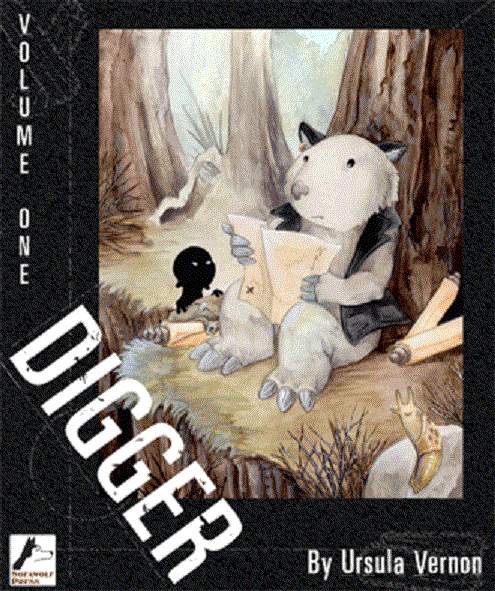Comic Strip Review: Digger Volume One by Ursula Vernon
Digger of Unnecessarily Convoluted Tunnels, “Digger” if you’re not being formal, is a wombat. In her world, wombats are an intelligent bipedal species which otherwise resemble Earth’s wombats. Digger’s primary job is being a tunneler, but when we meet her, she no longer remembers where her tunnel was headed. As far as she can make out, she hit a patch of “bad earth” that’s disoriented her and given her short-term amnesia. Now that she’s come to her senses, though, she does know up from down, and if you dig “up” far enough, you will eventually reach the surface.

Digger finds herself in a temple, talking to a statue of Ganesh, the god of compassion. The statue is home to a fragment of the god, but is not the god itself, so is somewhat limited. Digger’s people are not unfamiliar with the concept of gods, as they run into them buried underground all the time, but do not worship them and usually avoid interacting with them. Wombats are a practical people who do not trust magic.
Still, Ganesh is a reasonable person, for a god-haunted statue. Digger quickly establishes that wombats are not native to this area, and Ganesh has no idea where it is relative to her homeland. As night will fall soon, Ganesh suggests visiting the nearby village. A storm comes up, and Digger takes refuge in what she hopes is an empty cave. And this is the beginning of her adventures.
Ursula Vernon was, in 2007, primarily an illustrator who’d done a few pages of story as a lark to test out her wombat design (based on watching Steve Irwin interact with one). This came to the attention of T. Campbell, who was editor of the webcomic anthology site Graphic Smash. He encouraged her to turn it into a full series, which ran some 800 pages and won a Hugo award in 2012. Having discovered that people like her art and writing, she’s had several children’s books published under “Ursula Vernon” and books aimed at adults (dark fantasy and horror, mostly) as “T. Kingfisher”.
In this first volume, Digger explores the surroundings of the temple, meeting a hyena-person she nicknames “Ed” as his original name was eaten, the mysterious Shadowchild who doesn’t know what it is, and Ed’s former tribemates, who are anthropophagous. (But are also willing to eat wombats; they’re not picky.)
Returning to the temple, Digger meets Jhalm, captain of the Veiled, the servants of the gods. Jhalm is a suspicious sort who’s most interested in punishing the wicked, and Digger instinctively distrusts him.
An acolyte, unnamed at this point, explains the origin of the temple, a story Digger doesn’t quite believe. But Second Librarian Vo is a more affable fellow. He’s a learned man, quite elderly, and had previously thought wombats were mythical creatures. But he’s gathered all the information in the temple library on the subject and is willing to help Digger look.
Nothing in the initial search, but dwarven maps might be more helpful as they love drawing maps of their locations, and one might include the abandoned dwarfholt near Digger’s home warren. The apprentices will look into it.
Trying to find the village again, Digger meets Shadowchild again (the temple is dangerous for it) and they run into an oracular slug. After a digression that establishes exactly why there’s an oracular slug, it delivers two obscure prophecies to Digger. It also gives some non-magical and practical advice on where the village is and that it might not be safe.
The village is not safe, being under attack. Digger initially doesn’t want to take sides, but there’s a veiled woman huddling in the middle of the street who is not attacking anyone and not in a mind to do anything but pray. When Digger attempts to help the woman to a safer place, she is attacked by bandits. She takes out several of them, but a crossbow bolt finds a vulnerable spot.
Digger wakes up three days later in the hut of the local hag (healer), who’s new at the job, but nineteen is not too young to be a hag.
There’s quite a few mysteries being set up, and several characters who might be important later. As is the nature of webcomics, certain events were planned years in advance, while others were a matter of putting in dots to be connected later once the author thought of a connection. (Or just left as worldbuilding details.)
Digger is a good protagonist. She has a large dose of common sense, but is also a decent person, which means that sometimes she doesn’t do the safest thing. She’s very knowledgeable in her fields of expertise, but knows that she’s not in a place where she can refuse to learn new things, and asks obvious questions. Digger’s also a distinctive but relatively easy to draw character design, important when the artist is going to have to draw her over and over and over.
The art is charming, and I can see a gradual improvement over the course of this first volume.
Since there’s a bit of space left at the end of the volume (and not to split up chapters), there’s also a short story, “No Unicorns in Heaven” which explains the backstory of the statue that Ganesh inhabits.
As of this writing, the webcomic is still available online at https://diggercomic.com but buying the physical volumes (or the massive omnibus) ensures that you’ll be able to read them if you lose your internet connection and puts some money in the creator’s pocket.
Recommended to fantasy fans who enjoy talking animals–I’d say late teens on up, not so much for “content warning” as for a generally more grown-up sense of pace.

